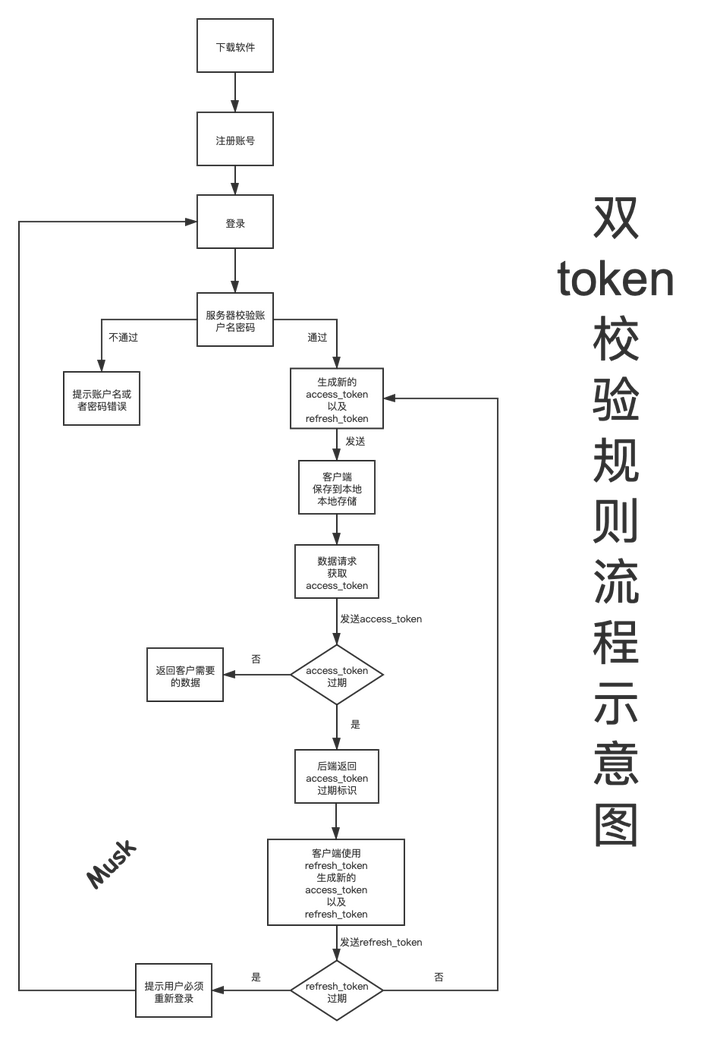## 背景
现如今,人人有手机,手机皆为苹果安卓等智能手机;
现如今,人人爱网购,网购皆为淘宝京东等电商平台。
喜欢网购的你是否发现,下载好淘宝京东,只要你时不时的用一下它,就不用登录了。
为什么呢?
从技术的角度而言,当用户在一定的时间内使用过该平台就可以不用再次登录,但一定要注意的是首次肯定得登录,如果用户操过一定的时间没有使用,就必须得重新登录,这种方式我们将它称之为双token。
## 流程示意图

具体说明如下:
- 1.根据需要下载软件,完成注册账户
- 2.登录账户,后端返回 两个token信息,分别为 access_token 以及 refresh_token,access_token称之为短token,refresh_token称之为长token
- 3.短token也就是access_token未过期,所有的请求一切都正常,用户需要什么数据就返回什么数据
- 4.access_token 过期,服务端返回一个状态码给客户端,客户端接收到该状态码之后,使用refresh_token重新获取一次新的 access_token 和 refresh_token,相当于重置token
- 5.如果在refresh_token有效期中没有使用过该软件,意味着refresh_token过期,使用它获取新的 access_token 和 refresh_token 时会返回新的一个状态码,提示用户必须登录
有的人可能会有如下疑问:
- 为什么在使用 refresh_token 时要返回新的 access_token 和 refresh_token,而不是延长 原来的 refresh_token 有效期?
- 为了安全,如果一旦 refresh_token 被黑客等人员截获到,他们就一直可以非法使用你的账号
- 即使一旦被截获,只要用户这边刷新就会重新获取到新的 refresh_token,那么以前的 被截获的 refresh_token 就会失效
## token的时间设置
token的时间设置需要看需求进行划分区别设置:
### PC网络应用
对于网络应用程序而言,由于token可以直接直观地获取到,因此不管是accessToken还是refreshToken为了安全起见,其过期时间都不应该设置得很长,且需要不停地更换token,因此PC网络应用的accessToken一般设置为2h过期,而refreshToken设置为1天到2天比较好,不足1天也是可以的,如果设置的时间比较短就在活跃期间时常刷新freshToken就好了,如果设置的时间比较长,就只需要设置一个阈值(比如7day的refreshToken设置一个6day阈值),在refreshToken小于等于这个阈值的时候就进行刷新refreshToken就好了。
### 手机应用
对于手机APP应用而言,登录操作一般只做一次,因此token的过期时间必是无限,即不会过期,不过为了安全起见(比如防止你丢手机),token应该以某种程度上对用户可见(比如在安全中心里检验了身份之后可以让你看到哪些设备有token,即哪些设备会被允许登录)并可让用户对其进行一定程度上的操作(比如你手机丢了,然后登录安全中心移除那个手机的token,也就是移除那个手机的登陆权限,从而使那个手机的应用上的你的帐号强制下线)
## 无效的Token的处理
对于频繁更换的Token,如何处理旧的未过期的而又无效的Token,以下提供了几个思路:
1. 简单地从浏览器中移除token就好了
显然,这种方式对于服务器方面的安全而言并没有什么卵用,但它能通过移除存在的token来阻止攻击者(比如,攻击者必须在用户下线之前窃取到token)
2) 制作一张token黑/白名单
在移除了浏览器存储的token后如果还想要再严格点,就只能在服务器上制作一张已经无效但是没过期的token的黑/白名单了,在每次请求中都操作数据库进行token的匹配,并以某种方式进行维护(不管是黑名单的定期删除维护也好,白名单的无效时删除也好),不过显然这种方式还是违背了token无状态的初衷,但是除此之外也没别的办法。
存储可以按照userId—token的方式存储在数据库中(当然也可以按你喜欢添加其他字段标明其他信息,比如说mac地址啦,是手机还是电脑啦,设备型号啦,巴拉巴拉巴拉····),白名单的话直接存储有效的token,在需要token无效的逻辑中删除指定token即可(比如刷新token的时候把旧的无效的但未过期的删掉)。而如果是黑名单的话就需要你定期去删除其中已经过期的token了。
而验证的话除了要去数据库名单里匹配之外还需要验证token本身的有效性。
3)只需要将token的过期时间设置的足够短就行了
## 如何刷新Token(引用自github)
```text
static refreshToken = (token): string => {
let optionKeys = ['iat', 'exp', 'iss', 'sub'];
let newToken;
let obj = {};
let now = Math.floor(Date.now()/1000);
let timeToExpire = (token['exp'] - now);
if (timeToExpire < (60 * 60)) { //1h
for (let key in token) {
if (optionKeys.indexOf(key) === -1) {
obj[key] = token[key];
}
}
let options = {
expiresIn: '7 days',
issuer: 'moi',
subject: token.sub,
algorithm: 'HS256'
};
newToken = JWT.sign(obj, Config.get('/jwtSecret'), options);
}
else {
newToken = ''; //no need to refresh, do what you want here.
}
return newToken;
}
```
## 刷新refreshToken的另一种思路(官网)
```text
/**
* Example to refresh tokens using https://github.com/auth0/node-jsonwebtoken
* It was requested to be introduced at as part of the jsonwebtoken library,
* since we feel it does not add too much value but it will add code to mantain
* we won't include it.
*
* I create this gist just to help those who want to auto-refresh JWTs.
*/
const jwt = require('jsonwebtoken');
function TokenGenerator (secretOrPrivateKey, secretOrPublicKey, options) {
this.secretOrPrivateKey = secretOrPrivateKey;
this.secretOrPublicKey = secretOrPublicKey;
this.options = options; //algorithm + keyid + noTimestamp + expiresIn + notBefore
}
TokenGenerator.prototype.sign = function(payload, signOptions) {
const jwtSignOptions = Object.assign({}, signOptions, this.options);
return jwt.sign(payload, this.secretOrPrivateKey, jwtSignOptions);
}
// refreshOptions.verify = options you would use with verify function
// refreshOptions.jwtid = contains the id for the new token
TokenGenerator.prototype.refresh = function(token, refreshOptions) {
const payload = jwt.verify(token, this.secretOrPublicKey, refreshOptions.verify);
delete payload.iat;
delete payload.exp;
delete payload.nbf;
delete payload.jti; //We are generating a new token, if you are using jwtid during signing, pass it in refreshOptions
const jwtSignOptions = Object.assign({ }, this.options, { jwtid: refreshOptions.jwtid });
// The first signing converted all needed options into claims, they are already in the payload
return jwt.sign(payload, this.secretOrPrivateKey, jwtSignOptions);
}
module.exports = TokenGenerator;
```
测试模块:
```text
/**
* Just few lines to test the behavior.
*/
const TokenGenerator = require('./token-generator');
const jwt = require('jsonwebtoken');
const tokenGenerator = new TokenGenerator('a', 'a', { algorithm: 'HS256', keyid: '1', noTimestamp: false, expiresIn: '2m', notBefore: '2s' })
token = tokenGenerator.sign({ myclaim: 'something' }, { audience: 'myaud', issuer: 'myissuer', jwtid: '1', subject: 'user' })
setTimeout(function () {
token2 = tokenGenerator.refresh(token, { verify: { audience: 'myaud', issuer: 'myissuer' }, jwtid: '2' })
console.log(jwt.decode(token, { complete: true }))
console.log(jwt.decode(token2, { complete: true }))
}, 3000)
```
更多关于web培训的问题,欢迎咨询千锋教育在线名师。千锋教育拥有多年IT培训服务经验,采用全程面授高品质、高体验培养模式,拥有国内一体化教学管理及学员服务,助力更多学员实现高薪梦想。





















 京公网安备 11010802030320号
京公网安备 11010802030320号